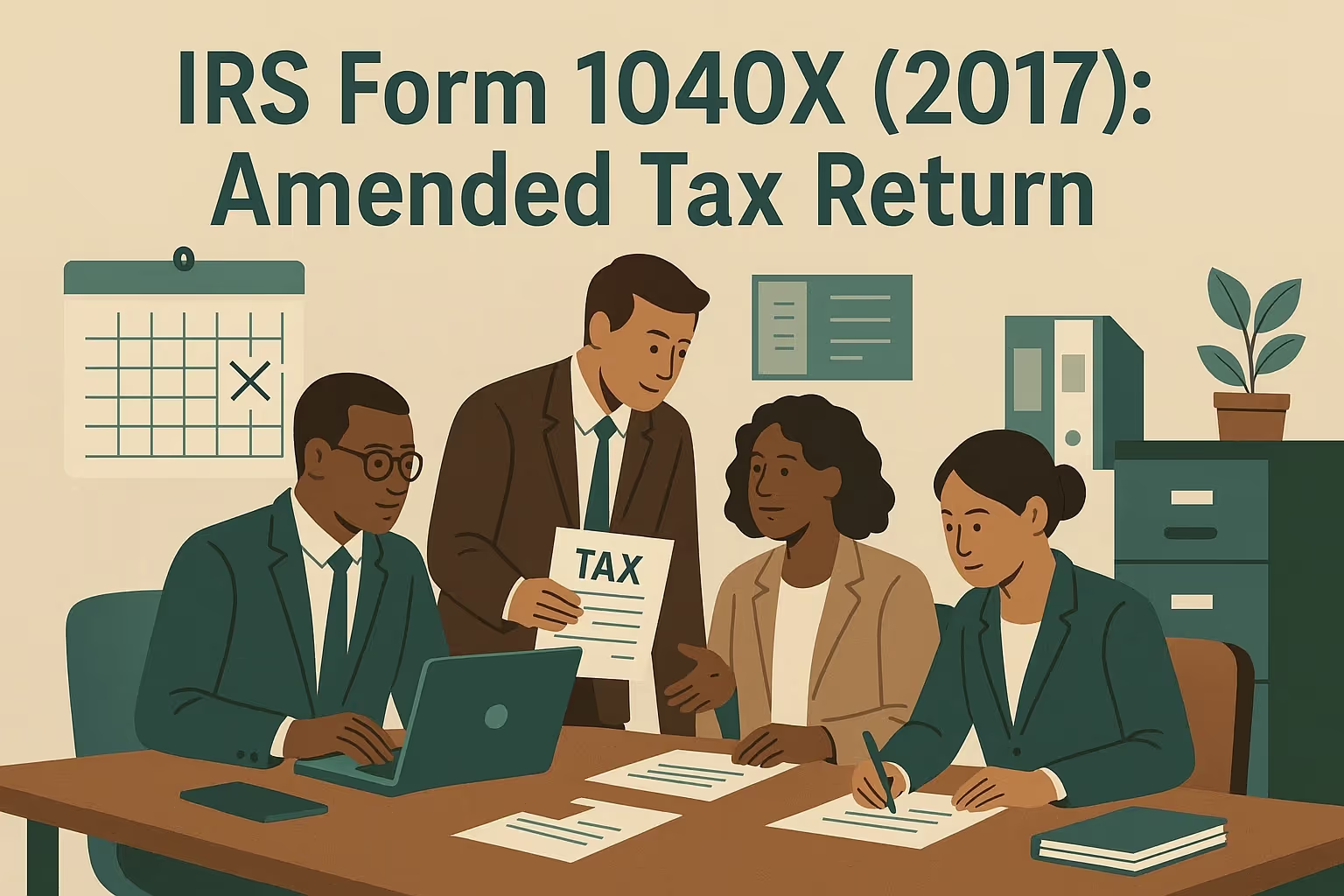IRS Form 1040X (2017): Amended Tax Return

What IRS Form 1040X (2017) Is For
IRS Form 1040X (2017) is used to correct your original tax return for the 2017 tax year. Taxpayers file this amended return to fix errors or make changes to their previously filed federal income tax return (Forms 1040, 1040A, 1040EZ, 1040NR, or 1040NR-EZ).
You may need to update deductions, credits, filing status, or other tax information that affects your refund or balance due. The purpose of this form is to ensure your federal taxes are reported accurately and that all required information matches IRS tax records.
For a detailed breakdown of filing requirements, eligibility rules, and step-by-step instructions for IRS Form 1040X (2017): Amended Tax Return, see our comprehensive guide
When You’d Use Form 1040X for 2017 (Late or Amended Filing)
You would file Form 1040X for 2017 if you received corrected W-2s, 1099s, or receipts showing unreported income. You might also use it to change your filing status, claim missed deductions, or respond to IRS notices about discrepancies.
The three-year refund statute expired in April 2021, meaning refunds are generally no longer paid for amended 2017 returns. However, you can still submit corrections if you owe additional taxes or need to adjust your federal income tax information.
Key Rules Specific to the 2017 Tax Year
The 2017 federal income tax return was the last before major tax reform. Taxpayers could still claim a personal exemption of $4,050 per person. Standard deductions were $6,350 for single filers, $12,700 for married filing jointly, and $9,350 for head of household.
Itemized deductions were not yet capped by the later $10,000 limit on state and local taxes. If you are checking your 2017 records, ensure your estimated tax payments, other taxes, and credits match the information on your original return.
For more resources on filing or understanding prior-year IRS forms, visit our guide on Individual Tax Forms.
Step-by-Step Process for Filing an Amended Return
Follow these steps to complete and file your amended return correctly:
- Gather documents: Collect your original tax return, all supporting schedules, receipts, and current tax records.
- Complete Form 1040X: Enter original amounts, corrected figures, and changes in the three-column format.
- Attach forms and schedules: Include all relevant forms, such as Form 1040, along with explanations and supporting calculations.
- Explain changes: In Part III, clearly explain what you’re changing and why. Provide an example if needed.
- File by mail: The IRS does not allow electronic filing for 2017 amended returns. Send the form to the address listed in the instructions.
- Check progress: You can find your refund or processing status on the IRS website using the “Where’s My Amended Return” tool after three weeks.
- Keep copies: Keep all documents and correspondence for your records.
Common Mistakes and How to Avoid Them
- Filing multiple returns: Submit only one original tax return per year.
- Missing documentation: Always attach corrected forms and tax schedules.
- Incomplete calculations: Update all affected lines, not just the one with a change.
- Using the wrong form: Use Form 843 for penalty refunds, not Form 1040X.
- Omitting explanations: Explain all corrections in Part III to avoid processing delays.
- Failing to sign and date: Both spouses must sign if filing jointly.
What Happens After You File
The IRS generally takes 8–12 weeks to process an amended return. Complex cases can take longer to resolve, especially if additional taxes or interest are due. You can check your status on the IRS website once three weeks have passed since submission.
Refunds are mailed as paper checks. If you owe taxes, pay promptly to reduce penalties and interest. You may request a payment plan using Form 9465 if you are unable to pay the full amount. Always send payments separately from your 1040X to ensure proper crediting.
Frequently Asked Questions
Can I still get a refund from my 2017 amended return?
Generally, no, you cannot. The refund statute for 2017 expired in April 2021. Only taxpayers who fall under notable exceptions, such as those with military service or a disability, may still qualify. Refunds are no longer paid after the due date, unless one of the following exceptions applies.
Do I need transcripts before filing?
They’re not required, but they help ensure accuracy. Visit the IRS website to find your tax records and verify income, deductions, and payments before you submit. Checking your transcripts can help you avoid mistakes and delays.
Should I also amend my state return?
Yes, many states require an amended return if your federal tax return changes. Contact your state tax agency for updated instructions and address information to ensure compliance with current regulations.
What penalties or interest apply?
If you owe additional money, penalties may be added monthly along with interest from the original due date. Filing promptly helps limit added costs. The IRS generally encourages taxpayers to pay as soon as possible to avoid incurring additional interest.
Can I file electronically for 2017?
No, amended returns for 2017 must be mailed to the address shown on the form instructions. Include all pages, schedules, and explanations. Use certified mail and keep proof of when you send it.
For more resources on filing or understanding prior-year IRS forms, visit our Form Summaries and Guides Library.







